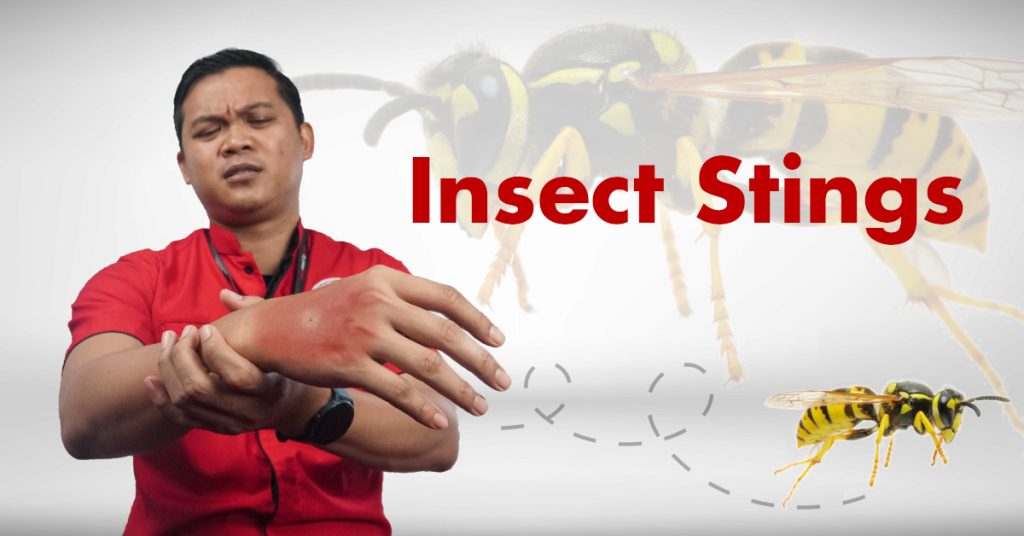Call Us +603-8066 8665
Basic Life Support for Insect Stings: Managing and Treating in Malaysia
Insect stings are common occurrences in Malaysia due to its tropical climate and abundant insect population. While most insect stings result in mild discomfort and localized reactions, some individuals may experience severe allergic reactions, making it crucial to understand how to manage and treat these incidents, even with basic life support (bls training). This essay will discuss insect stings in Malaysia and provide guidance on how to effectively manage them using BLS principles.

Malaysia’s diverse ecosystem supports a wide variety of insects, including bees, wasps, ants, and various species of mosquitoes and other biting insects. Insect stings are often characterized by localized pain, itching, redness, and swelling at the sting site. While most people experience only mild reactions, others may be hypersensitive, leading to severe allergic responses, known as anaphylaxis.
Basic Life Support (BLS) for Insect Stings:
- Scene Safety and Assessment:
Ensure the safety of the victim and yourself. Make sure the victim is away from the insect or potential danger. Assess the victim’s condition. Check for signs of an allergic reaction, such as difficulty breathing, swelling of the face or throat, hives, or a rapid pulse.
- Call for Help:
If the victim is showing signs of anaphylaxis (severe allergic reaction), call for emergency medical assistance immediately (Malaysia’s emergency number is 999 or 112).
- Remove the Stinger:
If a bee or wasp stinger is visible, use a blunt object like a credit card to gently scrape it off the skin. Do not use tweezers, as it can squeeze more venom into the wound.
- Wash and Clean:
Clean the sting site with soap and water to reduce the risk of infection.
- Pain and Swelling Management:
Apply a cold compress or ice pack wrapped in a cloth to the affected area to reduce pain and swelling. Also, over-the-counter pain relievers, such as paracetamol, can help manage discomfort.
- Monitor Vital Signs:
Keep an eye on the victim’s vital signs, including breathing rate, heart rate, and level of consciousness. Be prepared to initiate CPR if necessary.
- Comfort and Reassurance:
Keep the victim calm and reassure them. Encourage them to lie down with their legs elevated, especially if they are experiencing significant swelling.
- Allergic Reaction:
If anaphylaxis is suspected and emergency help has not arrived, assist the victim in using their prescribed epinephrine auto-injector (if available). Lay the victim on their back and elevate their legs to help with blood circulation.
Insect stings are a common occurrence in Malaysia, and while most cases result in mild discomfort, it is essential to be prepared to manage and treat severe allergic reactions using basic life support (BLS) principles. Immediate recognition of anaphylactic symptoms, prompt activation of emergency services, and proper stinger removal and wound care are essential steps in providing effective BLS for insect stings. By following these guidelines, we can ensure the safety and well-being of individuals who experience insect stings in Malaysia.
Insect Stings: Venom, Types, and Treatment
Insects are a diverse group of creatures found in every corner of the world. While most insects play essential roles in ecosystems, some can pose a threat to humans through their venomous stings. Insect stings can cause various reactions, ranging from mild discomfort to life-threatening allergic reactions. Understanding the types of venom associated with different insects and the appropriate treatment methods is crucial for minimizing the risks and ensuring prompt medical attention when needed.
Types of Venom
- Hymenoptera Venoms:
Hymenoptera is a large order of insects that includes bees, wasps, and ants. Their stings typically inject venom, which can vary in composition. Bees primarily inject a mixture of proteins and peptides, while wasps and ants introduce alkaloid venom compound.
- Bee Stings:
Bee venom contains melittin, a potent toxin that can cause localized pain, redness, and swelling. Some individuals may experience severe allergic reactions called anaphylaxis.
- Wasp Stings:
Wasp venom contains substances like histamine and acetylcholine, which can cause intense pain, itching, and localized swelling. Anaphylaxis is also a risk.
- Ant Stings:
Certain ant species, such as bullet ants, deliver painful stings. Their venom often contains peptides that cause intense pain, earning them the nickname “24-hour ants.”
- Arachnid Venoms:
Spiders, although not insects, can also deliver venomous bites. Venom composition varies between spider species.
- Black Widow Spider:
Black widow venom contains neurotoxins that affect the nervous system. Symptoms include muscle pain, cramps, and nausea. Severe bites can lead to respiratory issues.
- Brown Recluse Spider:
Brown recluse venom contains necrotic enzymes, causing tissue damage around the bite. Symptoms include a painful ulcer and, in severe cases, systemic symptoms.
- Diptera Venoms:
Flies, including mosquitoes and horseflies, can transmit diseases through their bites rather than venom. However, the saliva they inject can cause itching and allergic reactions in some individuals.
Treatment Methods
Bee Stings:
Remove the stinger gently using a flat object, clean the area, and apply a cold compress. Over-the-counter pain relievers and antihistamines can help with discomfort and itching. Seek medical attention if experiencing severe allergic reactions.
Wasp Stings:
Similar to bee stings, remove the stinger if present, clean the area, and apply a cold compress. Pain relievers and antihistamines can alleviate symptoms. Anaphylactic reactions require immediate medical attention.
Ant Stings:
Clean the sting site, use cold compresses, and take pain relievers. Some ant stings may require medical attention due to intense pain.
Spider Bites:
Black Widow Bites: Clean the wound, apply a cold compress, and seek medical attention. Antivenom may be necessary for severe cases.
Brown Recluse Bites: Clean the wound and apply a cold compress. Seek medical attention promptly, especially if symptoms worsen.
Mosquito Bites: Apply anti-itch creams or lotions to reduce itching. Avoid scratching to prevent infection.
Horsefly Bites: Clean the wound, apply an antiseptic, and use pain relievers for discomfort. Seek medical attention if the bite becomes infected.
Insect stings can vary widely in their severity and the types of venom they deliver. Understanding the different types of venom and appropriate treatment methods is crucial for managing the symptoms and, in some cases, preventing life-threatening allergic reactions. While many insect stings can be managed at home, it is essential to seek immediate medical attention when experiencing severe symptoms or signs of anaphylaxis to ensure a prompt and effective response to the venomous threat.



